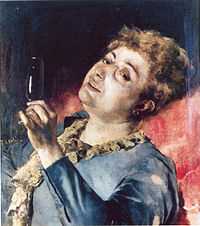Antonio Cortina Farinós

Antonio Cortina Farinós (16 February 1841, Almácera - 6 November 1890, Madrid) was a Spanish painter, decorator and art teacher.
Biography
While he was still just a child, his parents would send him to the streets of Valencia to collect manure for the family farm. As a result, he acquired the nickname "El Femateret" (roughly, the "Little Gardener"),[1] which would follow him throughout his life. While there, he would visit the studios of a local sculptor named Rafael Alemany, where he first displayed a talent for art. Thanks to Alemany, he began to audit classes at the Real Academia de Bellas Artes de San Carlos de Valencia at the age of ten.

He soon attracted the attention of the professors, due to his habit of drawing cartoons in charcoal on streets and walls[1] which, although roundly and properly condemned by the property owners, did display his talent to good effect. His behavior even merited an article in the local newspaper.
In 1856, he received a fellowship of 3,000 Reales that enabled him to study at the Academia full-time until 1862.[1] Five years later, he won a Silver Medal at the "Exposición Regional de Valencia" and took a Gold Medal at the "Exposición de Bellas Artes del Ayuntamiento de Valencia" in 1872. He became an honorary member of the "Ateneo Científico y Literario de Valencia" in 1877 and was appointed an Assistant Professor of line drawing at the Academia in 1884.

(date unknown)
In addition to his painting, he designed rides for a local festival and provided decorations for several cafés in Spain and France. He also produced murals for a number of churches throughout the Valencian Community.[1]
In January 1890, following the death of Professor Rafael Berenguer y Condé, Cortina became the Acting Professor of Line Drawing and sought to be permanently appointed to that chair. Later that year, he went to Madrid as part of the application process but, in early November, was found dead in the attic of his residence on Calle de la Palma, apparently the victim of a robbery.[1] The official cause of death was given as "cerebral congestion" from a blow to the head. Following the memorial service, several of his artist friends auctioned off a selection of their works to raise money for Cortina's widow and children. In 1897, his remains were returned to Valencia and deposited in the Pantheon at the city cemetery.
References
Further reading
- María Ángeles Arazo, “Fantasía en los murales”, Miguel Ángel Catalá Gorgues, “Una peculiar contribución a la iconografía de los ángeles de Antonio Cortina” and Luis Morote Greus,“Cortina” in Redescubriendo al pintor Antonio Cortina 1841-1890. Exhibition catalog. Valencia: Consorcio de Museos de la Comunitat Valenciana, 2014. ISBN 978-84-482-5963-1
- Carmen Pinedo Herrero and Elvira Mas Zurita, El profesor que trajo las gallinas a la Escuela. Antonio Cortina Farinós (1841-1890). Valencia: Institució Alfons el Magnànim, 2007. ISBN 978-84-7822-493-7
- Consuelo Llopis Bauset, Antonio Cortina Farinos: Pintor 1841-1890. self-published, 2004. ISBN 84-932-5974-8
External links
| Wikimedia Commons has media related to Antonio Cortina Farinós. |
- Documents for an Exposition by Carmen Pinedo Herrero
- Las Provincias: "El nieto de Cortina confirma que las pinturas del Ateneo son de su abuelo y no de Sorolla" by Lola Soriano
- Área de Conservación de Patrimonio Cultural, Universitat de València: "Antonio Cortina Farinós: una exposición malograda"
|